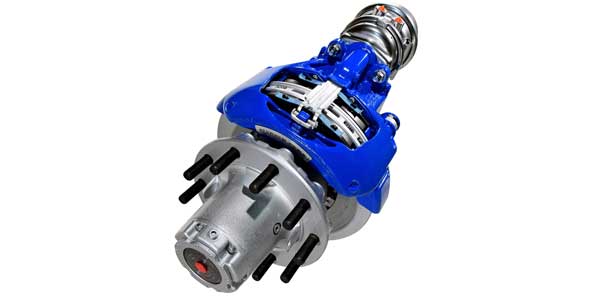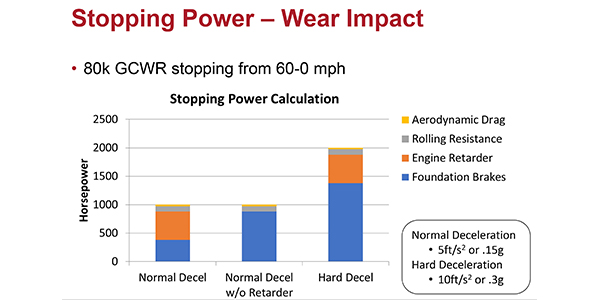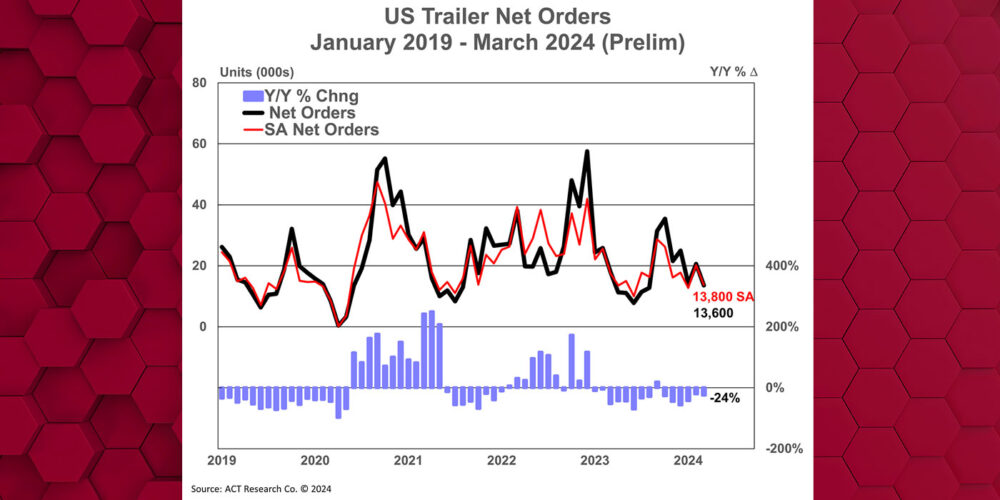Even as air disc brakes become increasingly popular in North American commercial vehicle fleets, concerns of brake system balance—the amount of work handled by each brake in a system—may arise when they are installed in combination with drum brakes. While these hybrid braking setups deliver advantages in stopping power and uptime, it’s important to understand the role that brake balance plays in determining system performance and friction life.
In this Tech Tip, Bendix takes a look into combination disc/drum braking systems, including what to expect on the road and in the shop, as well as advice for introducing air disc brakes to a fleet.
RELATED: What you need to know about air disc brakes as they increase in popularity
The fade factor
As a drum brake heats up, particularly during heavy braking, it’s prone to brake fade—a reduction in performance due to expansion of the drum away from the brake shoe friction. In contrast, the design of an air disc brake virtually eliminates brake fade.
“One of the things Bendix continues to make fleets and drivers aware of is how that fading affects the brake balance on a vehicle, particularly tractor-trailer combos,” said Joey Campbell, product manager of air disc brakes at Bendix Spicer Foundation Brake (BSFB). “Different vehicle configurations and operating conditions, including how the truck is used, will push the workload to different axles, which makes a difference not just to the driver, but in maintenance planning and determining total cost of ownership (TCO).”
Under typical braking conditions, in a properly balanced air brake system, each wheel-end brake on a vehicle is going to handle an appropriate amount of work based on weight—regardless of whether it’s a disc or a drum, or whether it’s on the tractor or trailer. Under heavy brake conditions where the brakes generate a lot of heat – situations associated with higher speed stops, higher GCWs, and/or extended downhill stretches – as the entire brake system works harder, the drum brakes will begin to fade. This has the effect of pushing the work they’re no longer handling onto the air disc brakes.
“You’ll still get the stopping performance, but you could see decreased pad life on the air disc brakes (ADB) as they compensate for the extra work done during drum brake fade,” Campbell explained. “This has led to questions about deliberately imbalancing an air brake system to compensate for the drum brake fading and keeping that extra work from shifting to the ADB wheel-ends in order to prolong the disc friction life.”
Bendix, he noted, strongly advises against this, since brake fade generally occurs in temporary situations that account for only a small percentage of a vehicle’s operating time. Since most brake applications occur under normal conditions, these stops would now be taking place using an imbalanced system, hampering the normal brake performance for the sake of optimizing the small slice of time that brake fade situations represent.
Discs and dollies
Introducing disc brakes to a fleet through most standard tractor-trailer combinations is a straightforward proposition, and it generally doesn’t matter whether a fleet or driver begins with discs on a tractor or the trailer. When multiple trailers (for example, doubles, triples, etc.) come into play, though, dollies introduce a wrinkle worth addressing.
Bendix testing has shown that on an all-drum-braked tractor and double trailer, equipping the connecting dolly between the trailers with air disc brakes will likely lead to accelerated pad wear until fleet population of disc brakes increases.
“If you’re putting air discs on only one axle out of six or more axles, the air disc brakes on the single axle are going to see an increase in temperature as they take on the extra work when the drum brakes fade,” Campbell said. “Disc brakes can handle the heat, but the friction wear will be accelerated since the work balance is shifting towards the ADB dolly. And again, we tested this—increasing the crack pressure on the dolly and delaying the disc brake application so that the drum-braked axles would take more of the work—but it didn’t make a meaningful difference, so we don’t recommend it.”
For those reasons, he noted, Bendix recommends introducing discs first to tractors or trailers, and utilizing disc-braked dollies only in combination with other disc-braked equipment.
Talking TCO
One of the most common questions from fleets and drivers considering air disc brakes is “How much longer is the pad life?” It’s an understandable one, since the cost of replacing brake friction is a key component of measuring the return on investment in ADB technology. And equipment spec’ing matters.
Other components also contribute to the deceleration of a vehicle outside of the foundation brakes. While their original intent is not to help with braking, their contribution to overall deceleration is somewhat a byproduct.
Take, for instance, vehicles that are spec’ed without some of the aerodynamic devices – such as side skirts and aero bumpers – that help air flow around the vehicle. Vehicles without these devices have a higher aerodynamic drag, which contributes to deceleration, mostly at higher speeds. Other components – like tire rolling resistance, as well as the impact of transmission downshifting – can, and will, play a role in deceleration. When some of these things are included, they can have an added impact on the life of a vehicle’s friction by taking some of the workload off of the brakes.
One often overlooked consideration is an engine brake, also known as an engine retarder. Under normal deceleration (5 ft. per second squared, or about .15 g), an 80,000-lb. vehicle uses about 1,000 HP to stop from 60 MPH. An engine retarder typically handles about 50% of that work, leaving just under half the work to the foundation brakes, with the remainder absorbed by aerodynamic drag and rolling resistance.
How a driver regularly handles stops affects brake pad life in a few ways.
“Take that same 80,000-pound vehicle: Stopping it from 60 mph using hard deceleration (10 ft. per second squared, or about .3 g) requires double the horsepower,” noted Campbell. “An engine retarder maintains the same level of assistance as under normal deceleration—about 500 HP worth—but since the overall need is now 2,000 HP, the foundation brakes on that system are taking about triple the load they’re handling under normal deceleration. And again—the more work they do, the faster those pads will wear. Just think what that would be without the engine retarder.”
“We’ve seen some fleets adopt air disc brakes, but then figure they didn’t need an engine retarder due to the higher performance of the ADBs,” Campbell said. “The problem is that while ADBs are more than capable of exceeding today’s stopping distance standards unassisted, that extra workload with every stop is going to have a huge impact on the life of their friction. As a result, it is not a true apples-to-apples comparison if you compare the friction life of a drum brake paired with an engine retarder to an ADB without one.”
Campbell also stressed the importance of OEM-quality replacement drum brake friction when relining. An aftermarket drum brake friction with a higher propensity to fade won’t just impact performance—it will pass that impact along to ADBs by transferring even more work to them. ADB friction is also important as OEM friction is designed to provide stopping performance while also managing wear.
This article was contributed by Bendix as part of the Bendix Tech Tips series.















